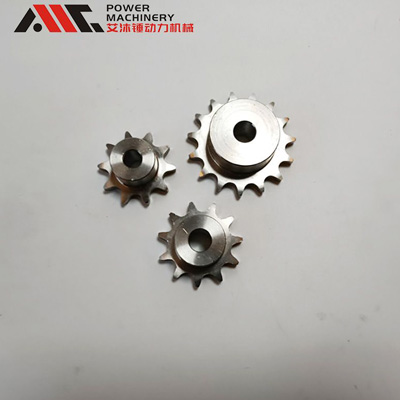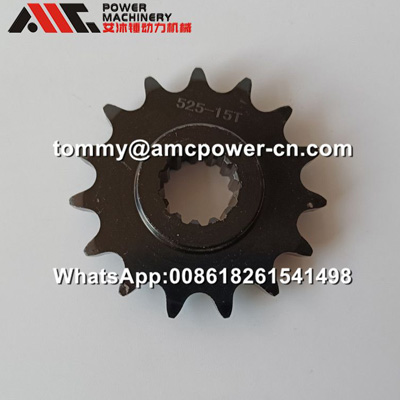Notes on Sprockets And Chains
A sprocket is a cog on a sprocket. Contrary to popular opinion, sprockets are not cogs.
A die is a cog on a sprocket. Contrary to popular opinion, sprockets are not cogs.
Chain sizes
The chain type is identified by a number; IE. 40 size chain. The number on the far right of the standard size chain is 0; 1 for lightweight chains; and 5 for rollerless bushing chains. The number on the left indicates the pitch of the chain in eighths of an inch. For example, a size 40 chain has a pitch of four-eighths of an inch or 1/2" and has standard dimensions for width, roller diameter, etc.
The roller diameter is the "nearest binary fraction" (32") to 5/8 pitch; the pin diameter is half the roller diameter. For "standard" (Series 0) chains, the width of the chain is the nearest binary fraction of 5/8 pitch; for narrow chains (Series 1), the width is 41% of the pitch. The thickness of the chain wheel is approximately 85-90% of the width of the roller.
The thickness of the plate is 1/8 of the pitch, except for the "extra heavy" chain indicated by the suffix H, which is 1/32" thicker.

304 Stainless Steel Sprocket
Choosing a chain
Two factors determine the choice of chain; the working load of the sprocket and the speed. The working load sets the lower limit of pitch and the speed sets the upper limit.
Maximum pitch = (900 ÷ rpm ) 2/3
The smaller the pitch, the less noise, wear and mechanical losses experienced.
Sprockets
There are four types of sprocket wheel.
Type A: Plain Plate sprockets
Type B: Hub on one side
Type C: Hub on both sides
Type D: Detachable hub
Depending on the application, the sprocket should be as large as possible. The larger the sprocket, the lower the working load for a given transmitted power, allowing the use of smaller pitch chains. However, the chain speed should be kept below 1200 feet per minute.
The size of the sprocket can be calculated according to the following formula, where P is the chain pitch and N is the number of teeth of the sprocket.
Pitch circle diameter = P ÷ sin (180° ÷ N)
Outer diameter = P × (0.6 + cot ( 180° ÷ N) )
Sprocket thickness = 0.93 × roller width - 0.006"

525 15T Front Motorcycle Sprocket for Honda CB400
Steps to lay out the sprockets
The first thing you need to know in order to lay out a sprocket is the dimensions of the chain to be run on the sprocket, in particular the pitch, the roller diameter and the roller width of the chain. The second thing you need to know is the number of teeth of the sprocket, which depends entirely on your application. From these numbers you can calculate the outer diameter and thickness of the required blank.
You also need to know the angle between the teeth - this is simply 360° divided by the number of teeth.
Application
The chain wheels should be aligned exactly on a common vertical plane and their axes parallel. The chain should be clean and well lubricated with a thin, light oil that will penetrate the small gap between the pin and the bushing.
The centre distance should not be less than 1.5 times the diameter of the larger sprocket, nor less than 30 times the chain pitch, and not more than 60 times the chain pitch. The centre distance should be adjustable - one chain pitch should be sufficient - if not, an idler pulley should be used to adjust the tension. A slight slack is desirable, preferably at the bottom of the drive.
The chain should be at least 120° around the drive sprocket, requiring a ratio of no more than 3.5 to 1; for greater ratios, idlers may be required to increase the wrap angle.